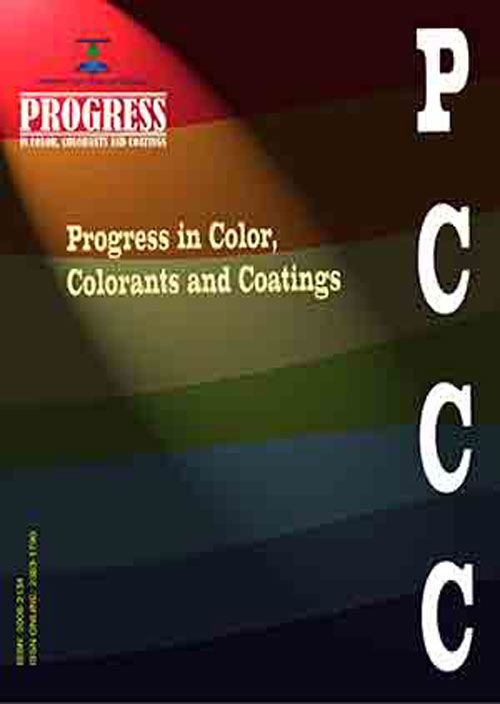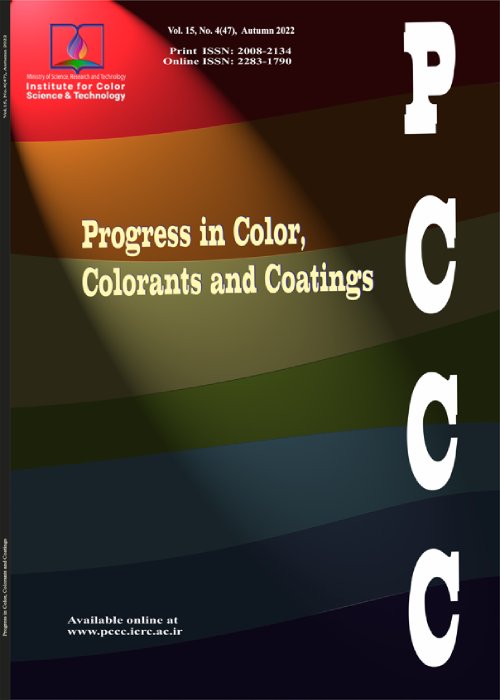فهرست مطالب

Progress in Color, Colorants and Coatings
Volume:15 Issue: 2, Spring 2022
- تاریخ انتشار: 1400/06/03
- تعداد عناوین: 8
-
-
Pages 75-85A novel "turn-on" nano chemosensor for Hg2+ was developed based on CoFe2O4@SiO2 nanocomposite. Cobalt nano ferrite particles were decorated with 1,8-naphthalimide dye conjugated with rhodamine dye. It was characterized using X-ray powder diffraction (XRD), transmission electron microscopy (TEM), FT-IR techniques. A fluorescence enhancement was observed upon binding Hg2+ to two core chromogenic dyes. No significant change in the fluorescence intensity was observed in the presence of other metal ions. The results showed that the functionalized nanocomposite CoFe2O4@SiO2/NR exhibited selective 'turn-on' fluorescent enhancements with Hg2+. Also, the company of magnetic CoFe2O4@SiO2 nanocomposite (with a wide range of applications such as biomedicine, magnetic fluids, magnetic energy storage) and catalysis facilitates the magnetic separation of the Hg (II) from the solution. Nano chemosensor exhibits high selectivity, high sensitivity and fast response to trace mercury ions. Designed nanosensor successfully applied for Hg2+determination at real samples with a linear range of 0.04-0.76 μM of Hg2+ ions. It was successfully applied for the determination of mercury ion in real samples of tap water. It seems that the presence sensor is a suitable candidate for the detection of trace mercury ion in biomedical samples like a human serum. Also, it is fast and easy control for monitoring of water toxicity of pollutant industries.Keywords: Naphthalimide, Rhodamine, Magnetic, Fluorescence, CoFe2O4@SiO2, Nanocomposite
-
Pages 87-96Reactive dyes with fluorescent properties are among the most demanded. However, these dyes have a limit in hues since there is no full range of these dyes in the commercial. Therefore, in this research, we presented a xanthene-based bi-functional reactive dye with the fluorescent property. In this regard, the first 2,4,6-trichloro-1,3,5-triazine was reacted with 1-amino-2-methoxy-4-beta-hydroxy ethyl sulphone sulfate ester, and then the obtained product was reacted with 2-(6-hydroxy-3-oxo-3H-xanthene-9-yl). The dye characteristics were studied by TLC, 1HNMR, 13CNMR, FTIR, elemental analysis, UV-Vis spectrophotometer, and spectrofluorimeter techniques. The photophysical properties of a synthesized dye, such as absorption and emission wavelength maxima, quantum yield, stokes shift, and energy yield, were measured. The effect of polarity of solvents on the photophysical properties of synthesized dye was explored using four polar and nonpolar solvents (water, DMF, methanol and acetone). The results indicated that the synthesized dye showed a positive solvatochromism effect. The absorption and emission wavelengths were 465-490 nm 498-538 nm, respectively. The quantum yield of synthesized dye was in a range of 0.04-0.66 in different solvents.Keywords: Photophysical property, fluorescent, reactive dye, Solvatochromism, Quantum yield
-
Pages 97-109Inhibition effects of 5-aminosalicylic acid (5-ASA) on the under deposit corrosion of X60 steel in 3.5 % NaCl solution saturated with CO2 have been investigated by the techniques of potentiodynamic polarization and electrochemical impedance spectroscopy (EIS). The sand-covered electrode was prepared by covering the X60 steel electrode with a layer of silica sand. The increase of 5-ASA concentration up to 600 ppm led to increasing the inhibition efficiency of X60 steel against under deposit corrosion in the brine solution. The Langmuir isotherm can describe the adsorption behavior of 5-ASA on the surface of the steel. Measurements of potentiodynamic polarization indicated that 5-ASA is an anodic inhibitor. The effects of temperature on the under deposit corrosion behavior of carbon steel were studied both in the absence and presence of 600 ppm 5-ASA. The enthalpy of the 5-ASA adsorption was obtained from the temperature dependence of the corrosion inhibition process. A reasonable agreement was observed between the IE values resulted from the Tafel and the EIS techniques. The electronic properties of 5-ASA were calculated in both the gas phase and the aqueous phase by a density functional theory (DFT) approach to establish the relationship between the inhibitive effect and molecular structure of 5-ASA.Keywords: 5-aminosalicylic acid (5-ASA), Under deposit corrosion (UDC), Density functional theory (DFT), Electrochemical impedance, Spectroscopy, potentiodynamic polarization
-
Pages 111-122There are significant losses at high costs for long periods due to the corrosion and damage it causes in most industrial processes, especially the oil and gas industries. The corrosion inhibition ability of N-methyl-2-(1-(5-methyl thiophene-2-yl) ethylidene) hydrazine carbothioamide (N-MEH) was examined. It was tested on mild steel in a 1 M hydrochloric acid solution. Gravimetric measurements and scanning electron microscopy (SEM) were used to confirm the effort compound as a corrosion inhibitor. The experimental results showed that the maximum inhibition efficacy of 95.3 % was performed at an optimal inhibitory concentration of 0.005 M and 303 K using weight loss techniques. SEM indicates that N-MEH molecules are absorbed onto the surface of mild steel. As a complementary technique, density functional theory (DFT) was used to look at the interactions between N-MEH molecules and mild steel surfaces. N-MEH molecules' adsorption on the surface of mild steel follows the processes of chemical and physical absorptions and obeys the Langmuir isothermal adsorption model.Keywords: Weight loss, Corrosion inhibitor, Langmuir, physisorption, SEM
-
Pages 121-129In this paper, four indoline-based organic dyes were introduced and studied as photosensitizers in the photovoltaic devices. The starting material for preparing organic dyes by standard reactions is carbazole and phenothiazine. The dyes' status changes are assessed by spectrophotometric measurements of the organic photosensitizers in acetonitrile and on a TiO2 and rGO/TiO2 substrate. The maximum absorption wavelength for Dyes 1-4 in acetonitrile, TiO2 films, and rGO/TiO2 was investigated. Finally, the proposed dyes used as a photosensitizer in a dye solar cell structure in the presence of rGO/TiO2 and their photovoltaic properties were investigated.Keywords: rGO, TiO2, Dye-sensitized solar cells, Organic photosensitizer, Photovoltaic, Efficiency
-
Pages 133-141
New corrosion inhibitors, namely N'-acetyl-4-pyrrol-1-ylbenzohydrazide (NAPB), were synthesized by the reaction of 4-pyrrol-1-ylbenzohydrazide with acetic anhydride. NAPB was characterized by FTIR and NMR spectroscopy. Weight loss measurement was used to evaluate the corrosion inhibition of Low-carbon steel in a 1 M hydrochloric acid medium. The inhibition efficiency (IE%) increased as NAPB concentration increases and decreases as the solution temperature increases. The inhibition efficiency reached 94.6 % at the optimum concentration (500 ppm) of NAPB. The scanning electron microscopy technique proved the formation of a protective layer from NAPB molecules as corrosion inhibitors on the Low-carbon steel surface. The adsorption isotherm of NAPB molecules on the surface of Low-carbon steel was confirmed to follow the Langmuir adsorption isotherm. Further, through quantum chemical calculations using density functional theory (DFT), the importance of inhibition performance and molecular structure of an inhibitor has been theoretically investigated. Both experimental and theoretical findings are consistent with one another.
Keywords: Corrosion inhibitor, low carbon, NAPB, DFT, Langmuir -
Pages 143-156
Recently, there has been an increasing interest towards the finishing of textiles (fibers, yarns, fabrics and nonwovens) using eco-friendly technology, which can achieve a wide range of functional properties and environmental benefits. This study is related to a modern eco-friendly bleaching technology that relies on Ultraviolet/O3 radiation of poly(lactic acid) fabric through simple technique. The effects of Ultraviolet/O3 radiation along with the pretreatments with distilled water, hydrogen peroxide, and hydrogen peroxide/sodium silicate solutions on the bleaching of the poly(lactic acid) fabrics were examined using UV-Visible and reflectance spectral method and the results were compared with that of virgin untreated samples. Ultraviolet/O3 bleaching routes were screened to obtain desired whiteness index (WI), tint factor (Tw), lightness/darkness (L*), redness/greenness (a*), yellowness/ blueness (b*), chroma (c*) and hue (h˚) of the bleached poly(lactic acid) fabrics. The optimal properties of the bleached poly(lactic acid) knitted fabric could be obtained at Ultraviolet/O3 irradiation for 80 min on the fabrics which pre-impregnated in a hydrogen peroxide solution with a wet pick up of 70 %, pressure of 1.1 bar and speed of 2 m/min. (Ultraviolet/O3/H2O2 bleaching system). The Ultraviolet/O3/H2O2 bleached fabric showed the best colorimetric properties (WI: 87.7, : -0.1, L*:94.227, a*:-0.106, b*:0.294, c*:0.2512, h˚: 98.6551). Moreover, the reflectance of this sample has increased significantly in the range of 400-450 nm which leads to a glossy withe shade on the fibers. The SEM images presented that after Ultraviolet/O3/H2O2 bleaching process, some fractures with nano scale size (about 130 nm) are formed on the poly(lactic acid) fabric surface. The ATR-IR spectrum of Ultraviolet/O3/H2O2 bleached poly(lactic acid) fibers displays more intense C–C–O absorption bands (1161 cm-1).
Keywords: Poly(lactic acid), Bleaching, Ultraviolet, O3, Whiteness Index, Eco-friendly -
Pages 157-174
As the most crucial choice in the heavy-duty protective coating industry, epoxy-based coatings suffer from insufficient toughness and impermeableness. So in this study, a reliable method that is, in turn, easy to be scaled up is designed and proposed. Through this method, a significantly toughened and mechanically improved epoxy nanocomposite film is suggested. This film is based on poly(amidoamine)-grafted (PAMAM) graphene oxide (GO). GO is synthesized and then modified through two consecutive steps; first, silane-grafted GO producing SiGO and second polyamidoamine (PAMAM)-grafted SiGO leading to HbpSiGO. FT-IR, TGA, and XRD results confirm a successful functionalization of the GO flakes. Dynamic mechanical thermal analysis (DMTA) results reveal that the nanocomposite film based on HbpSiGO possesses higher storage modulus (50 %), elevated glass transition temperature (18 %), and higher cross-linking density (237 %) compared to unfilled epoxy. According to tensile testing, HbpSiGO nanocomposite shows an increment in work of fracture (148%), elongation at break (52 %), and maximum stress (68 %) in comparison with neat epoxy.
Keywords: Epoxy, Nanocomposite coating, Graphene oxide, Surface modification, Mechanical properties


